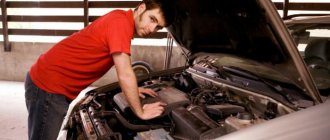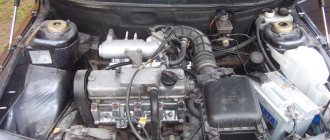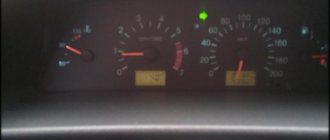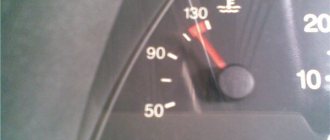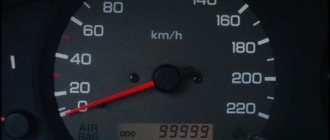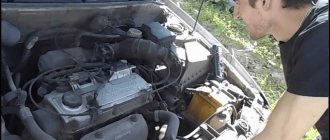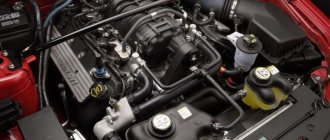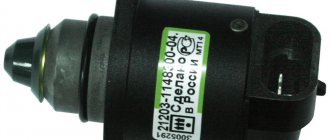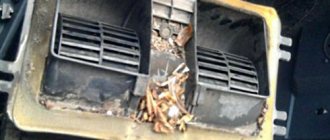Car : VAZ-2112. Asks : Alexander Glukhovsky. The essence of the question : the VAZ-2112 check light comes on and is blinking, what should I do?
On my hatchback with a fuel-injected engine, the check light started flashing. Once the effect went away on its own, then it appeared again. By the way, my engine is 1.5 liters.
I heard that on a VAZ-2112 the check light can light up just like that, but in my case the light is blinking! The sound of the engine also changes. So there is a reason.
Reasons for the appearance and blinking of the “check” on the VAZ-2112
If we consider engines with a volume of 1.5 liters, we can talk about one of two internal combustion engines: VAZ-2111 (8v) or 21120 (16v). In the first case, the ignition module 2111-3705010 is used, in the second - 2112-3705010. These modules are not capricious and do not often require repairs. We have already written about diagnosing the ignition module and repairing it.
Ignition system of the “tenth” family The following two tabs change content below.
The modules themselves, as you can see, are different, but they have the same “disease”. It is not the module that is to blame here, but its high-voltage connectors. The terminal may move away from any of the four connectors, but nothing will change externally. And after a while the terminal on the cable will burn out. Then the engine will begin to “trouble” and misfires will be noticed by the controller. Therefore, constant checking of the ignition module is necessary.
Let's clarify: at first the terminal comes off, but the current is carried out. Then charring occurs. On the dashboard of any car, including the VAZ-2112, the check will not light up immediately. And as soon as it lights up, check the contacts!
Is it possible to drive the car?
Some people drive for months and even years with a burning check, so many people think that there is nothing wrong with this and they can move around calmly if the engine is running. In reality, everything is not so simple. Breakdowns can be different. You can drive with one with virtually no changes in engine operation, but the second will cause big problems after a few hundred or even tens of kilometers.
Therefore, if possible, it is worthwhile to find out as quickly as possible what is causing the light bulb to burn. After this, make a decision about whether it is worth moving by car or whether it needs to be repaired.
What exactly needs to be done
Check the cap on each of the wires: if the copper is burnt, clean it with ASIDOL, ammonia and ordinary chalk. The taps on the module should also be cleaned. For better protection, you can apply lithium grease (Litol-24). Here's what you can't do:
- Check for the presence of a spark by bringing a “grounded conductor” to the tap;
- Connect the “+” terminal removed from the battery to ground with the engine running;
- Apply voltage “+12” to any of the module contacts.
How to perform an express check: the key is at “0”, then we measure the resistance between taps 2-3, 1-4. Both values must match. By the way, the multimeter must be a dial gauge.
Precautions: When connecting the multimeter to the module, do not touch two probes with your hands at the same time. The measurement limit is 100 kOhm or 10 kOhm.
Replacing spark plugs and high-voltage wires
Spark plugs in a car are the main parts; they are designed to ignite the fuel mixture. With faulty spark plugs, the spark is not supplied correctly to ignite the gasoline mixture. With faulty spark plugs, it often happens that there is no spark or the timing of the supply of this spark is incorrect, and this affects the incorrect operation of the engine. If the spark plugs are not working correctly, you may feel slight jolts when accelerating the car, especially when starting from a standstill.
What are the reasons for the failure of spark plugs: -Most spark plugs in cars produced before 1996 must be changed every 25,000 - 30,000 thousand kilometers. In newer cars, these spark plugs last for more than 150,000 thousand km. But, nevertheless, these periods of planned replacement of spark plugs can be reduced due to various factors that are naturally associated with both fuel quality and driving style.
What needs to be done: -If your spark plugs have not been changed for a long time or you feel dips in the engine’s operation that are specifically related to the ignition, then you must immediately replace them with new ones without delay. Do not try to save money by untimely replacement of spark plugs, since the cost of the spark plugs itself is not as expensive as the work itself to replace them. By replacing old spark plugs with new ones, you will improve engine performance and reduce vehicle fuel consumption. Changing the spark plugs in your car yourself is quite easy. Basically, they are all easily accessible under the hood of the car. You only need a regular spark plug wrench to remove the spark plugs from the engine. It is also advisable to monitor the condition of high-voltage wires, since over time they can become unusable and allow electricity to pass through, which is transferred to the spark plugs, which can reduce the strength of the spark. Remember that regular replacement of spark plugs in accordance with the maintenance schedule for your car protects your exhaust catalyst from breakdowns, and at the same time improves the performance of the engine itself!
This article of ours was originally published in 2013, and was further updated with new information on 02/17/2020.
How to distinguish “gaps” from everything else
Let's consider the situation: it is difficult to start when hot. If it starts when cold, the check light then turns on, but after 20-30 minutes it goes out. In this case, we can conclude that there is a misfire. Well, they can even be caused by an insulation breakdown. And above we looked at what is typical for the 2112 family (but not for the 21124 engine).
This block is too smart. They can say that the check for the VAZ-2112 caught fire for no reason. This happens in cases where:
- The indicator turns on, then the engine is turned off and the battery is disconnected (disconnect the minus terminal for 10 minutes);
- After connecting the battery, no defects are observed. Start the engine - the check lamp does not light up.
In fact, the ECU actually remembers any defect (the occurrence of any error). But the “reset” is also performed by the system itself:
- When starting the engine;
- After the next test cycle.
For each error, one of two methods is used. And, in theory, there is no point in disconnecting the battery. If the “check” is constantly on, then you need to look for a defect. And “terminal tricks” usually don’t help.
Signs
How do you know if the engine is leaking? With such a malfunction, the check engine light does not always flash. Therefore, it is important to know third-party signs that may indicate a problem:
- Increased engine vibration. It is significantly noticeable at low and idle speeds.
- Spark plug color change. After removal, its head will be dark. Since the mixture does not ignite, the candle becomes covered with soot and soot.
- Increased fuel consumption. This sign is related to the previous one. Since the mixture does not ignite, it simply goes into the exhaust pipe.
- Loss of engine power. Since the engine runs on three cylinders, it does not have enough energy to produce the required torque.
- Exhaust sound. He will be unstable.
- The appearance of black or thick white smoke from the exhaust pipe.
- Intermittent jolts during acceleration and even motion. This symptom also indicates a misfire. This error is often related to the ignition system.
It is worth listening carefully to the nature of the engine. If the friction increases at medium and high speeds, it can be assumed that the valves in the engine are not working properly. One simple reason is increased valve clearance.
In any case, if one or more of the above symptoms are detected, it is worth taking corrective action.
How does the injector work?
The fuel injection system appeared in the middle of the last century, but became widespread at the end of the 20th century. It replaced the carburetor as the most economical, efficient and environmentally friendly engine power system. Unlike a carburetor system, the mixture is supplied using nozzles that spray gasoline, and air enters the system separately.
The basis of the injector’s operation is an electronic control unit, which is responsible for all processes occurring in the engine. It has an influence on the ignition system, power supply, and is also capable of displaying various parameters on the car’s on-board computer. The main task of the ECU is to regulate the composition of the mixture for various operating modes and select the correct ignition timing.
To select the composition of the mixture, you need to have certain information. Firstly, this is the amount of air, secondly, the angle of the crankshaft, and thirdly, have information about how much fuel remains unburned. Many modern systems also use a number of other information, but these are the most basic.
So, to adjust the mixture composition, the following set of sensors is used:
- Mass air flow sensor. In short, it is called a mass air flow sensor. Serves to determine the amount of air that enters the power system. The operation of the sensor is based on changes in the resistance of the thread, depending on the temperature.
- Crankshaft position sensor. Determines the position of the crankshaft to identify the moments at which fuel injection is necessary, as well as the spark that will begin to ignite the mixture. The crankshaft sensor works on the same principle as the Hall sensor.
- Lambda probe. Many people mistakenly call it an oxygen sensor, although this is not the case. Its task is to capture unburned gasoline vapors in the exhaust, so that if the norm is exceeded, the mixture is leaner to the required limits. Most often, it is used in conjunction with another sensor to increase the accuracy of measurements.
- Throttle position sensor. Necessary for adjusting the fuel supply if the load on the engine changes. For example, when driving on a hill, you need to set the mixture in such a way that no matter how you press the pedal, the car does not lose the desired dynamics.
An electric fuel pump is responsible for the fuel supply itself, which independently pumps the required amount of gasoline. It replaced the manual mechanical device. On this topic:
Check the fuel filler cap
Many drivers, in some cases, when the “check engine” indication appears, begin to think about serious problems with the engine; they do not even think of checking the tightness of the fuel system, which may be compromised due to a defect or an insufficiently tightened fuel tank cap. This is a very common reason for the appearance of the “Check” engine icon.
Reason for the error: - Leakage of the fuel system due to the passage of air through the filler cap of the fuel tank, as well as an increase in the fuel consumption of the vehicle, for which the vehicle’s diagnostic system will definitely display an engine error by turning on the “Check engine” indication on the vehicle’s instrument panel.
What needs to be done: -If when the “Check” indication appears, your car has not lost its power and there are no audible signs of engine damage (knocking, humming, creaking, etc. in the engine), then the first thing you need to do is check the gas tank for leaks. Your gas cap may be cracked or not tightened enough. If the gas tank cap was not tightened enough, then after tightening it all the way, you can continue driving the car for a while, and then look at the dashboard and see if the engine error disappears. To prevent the check engine light from appearing and lighting up, check the fuel filler cap regularly. Remember also that periodically this cover must be replaced with a new one!
In what cases does the check light come on?
Now you know that the operation of the injector is based on high-precision information that is collected from sensors and sent to the engine’s electronic control unit, and it, in turn, makes a decision about what the mixture and ignition timing should be. But what does the unit do if information from the sensor is not received for some reason? After all, at any moment a breakdown can occur, which will affect the operation of the entire system.
To ensure that the injector continues to operate, a special emergency mode was provided, which allows the engine to operate even if the sensor breaks down. The activation of the mode is accompanied by a special indicator on the instrument panel - an orange Check Engine or a simple icon in the form of an engine.
What happens in the ECU? After the information from the sensor stops coming, the emergency system is activated, which sets the supply of the air-fuel mixture only depending on the angular position of the throttle valve. In simple terms, the injector begins to work exactly like a carburetor.
The same is reflected in the autonomous idle system, which increases the speed for engine stability. During emergency mode, the speed reaches 1500, and sometimes higher, depending on the program settings.
The Check Engine light may come on if one of the sensors breaks down; in addition, if internal engine faults are detected, for example, a decrease in oil pressure, the system can also turn on the corresponding lamp. However, “check” does not always mean turning on emergency mode. After all, the motor has a huge number of sensors that do not affect the operation of the power system. Therefore, emergency mode can only be activated if the following sensors are broken or broken:
- Lambda probe
- Mass air flow sensor
- DPKV
- TPDZ
If any other electronic devices break down, the controller ignores this failure and only tells the driver that the sensor is faulty in the form of an icon on the instrument panel.
Replace the oxygen sensor (lambda probe)
The oxygen sensor in your car is part of the exhaust system that monitors how much oxygen is not burned in the engine combustion chamber. This sensor helps control the vehicle's fuel consumption. A malfunction of the oxygen sensor (lambda probe) means that the car computer does not receive the correct data and can significantly increase fuel consumption, and at the same time reduce engine power. Most cars have 2 to 4 oxygen sensors. If you have a home car error scanner, then by connecting it to the car you can easily find out which sensor needs to be replaced.
For what reason does the oxygen sensor in a car become unusable: - Over time, the sensor becomes covered with a layer of used and regular motor oil (oil soot), which reduces the accuracy of reading sensor readings for regulating the gasoline mixture and distributing optimal fuel consumption. A malfunction of the oxygen sensor in a car leads not only to increased fuel consumption, but also to an increased content of harmful CO2 substances in the exhaust.
What needs to be done: -If you do not change a faulty car oxygen sensor, this may lead to failure of the car catalyst (it may burst), which will result in expensive repairs for you. The cost of new catalysts is very high due to the precious alloys they contain. Some cars have several of these catalysts at once and their cost can reach up to 90 thousand rubles. So gentlemen, don’t delay replacing the oxygen sensor. Although replacing the sensor itself and its cost are decent, it is still not commensurate with the cost of the exhaust gas catalyst system itself. You can save money on replacing this sensor by doing it yourself. Many car manuals have detailed instructions on how to replace the oxygen sensor yourself. If you know where the oxygen sensor is located, then it will not be difficult for you to disconnect the faulty lambda probe and replace it with a new one. Remember that you cannot delay replacing this important element!
Set the timing marks correctly - otherwise you will bend the valves!
The VAZ-21124 engine has a special feature: no matter how its pulleys are turned, it does not bend its valves. With the 21120 engine (16v 1.5 l) such jokes will not work! If the pulley positions are not too far off, try putting on the belt and turning the mechanism to the “TDC 1 and 4” position. From now on, always use the following instructions:
- The crankshaft is set to the required position by checking the mark on the generator drive pulley (photo 1) or on the crankshaft pulley (photo 2);
Alternator drive pulley and crankshaft pulley
Exhaust and intake shaft pulley
In theory, on the VAZ-2112, marking is carried out the same way, no matter what engine we are talking about. Here are photos for engine 21120.
What it looks like in reality and in the instructions
Take the time to find the inspection window on the gearbox housing. There is another mark under the plug.
- The number of belt teeth between the “upper pulley” marks is exactly 16;
- The mark on the crankshaft pulley sometimes breaks off - use the control method “1” (photo 1) or “3” (lower photo).
Updates for VAZ-21124
On a 1.6 engine, all actions are performed in the same way as described above. There is one exception - the generator drive pulley is aligned according to the mark on the casing (see photo).
Generator drive pulley, motor 21124
However, if this mark is not there, use the proven method: 20 teeth are counted from the DPKV body. Instead of the 21st there should be a “pass”.
Two different 16 valves
For those who don't understand anything
The number of teeth on the crankshaft pulley is 21, on the camshaft pulleys – 42. When the crankshaft rotates 360 degrees, the camshafts rotate 180. In general, a complete engine cycle consists of two crankshaft revolutions (720 degrees).
If there is no fixing device, you can make it yourself. Even a puller for suspension springs will do (see photo).
Source
What are the dangers of “tripleting”?
When the engine runs on three out of four cylinders, not only does the engine power decrease, there is excessive fuel consumption, the smell of gasoline comes out of the exhaust system, and the trembling and trembling of the engine simply makes it difficult to feel comfortable inside the car. However, the troubles don't end there.
Possible reasons
In most cases, when the cylinder does not work, the culprit is one of the elements of the ignition system, which is responsible for igniting the fuel, or the injectors responsible for supplying the fuel.
The ignition system must be checked in the following order:
- Open the hood with the engine running and try to remember the timing of its operation by ear.
- Next, in order of priority, we inspect and then disconnect the high-voltage wires from the spark plugs.
We disconnect each wire from the spark plug in turn. (Example on an 8-valve engine).
A crack in the spark plug body is the reason for replacement.
Using this table, it is very easy to determine the condition of the candles.
If there is “smoking” or heavy carbon deposits on the spark plug, this prevents its stable operation; in this case, the spark from the spark plug is very weak or absent altogether. It is not enough to clean the spark plug or replace it with a new one; you need to find the cause of this phenomenon. Check whether the spark plug is selected correctly and whether it has the correct gap.
Dirty candle with an oil trail.
It is best to check the spark plug for the presence of a spark on a special stand, or on your own.
If a spark does not appear when checking the spark plug, or it is very weak, this may indicate the following problems:
- Replacement of high-voltage wires is required.
- Diagnostics required for the electronic control unit.
- The timing belt has moved several teeth due to insufficient tension. Read this article about how to replace it.
Remember that for the best and most thorough check and the cause of engine tripping, you can find out by doing engine diagnostics.
What else do you need to think about?
We were able to describe several of the most frequently repeated cases of this signal lighting up. The engine designs of different cars differ, so there may be other reasons for the appearance of an alarm signal. It will be best for you and your car if computer diagnostics of all car systems is carried out. To do this, you can use the services of specialized centers, but some “advanced” drivers do this on their own.
Pay more attention to your “iron horse”, use only high-quality fuel and consumables, then you won’t have to worry about why the check light comes on when driving. And if you do see an “alarming” signal, do not rush to extremes, but delve into the problem and eliminate it.
Prevention is better than repair
But first of all, it is necessary to find an answer to the question of why the VAZ-21124 jerks during acceleration. On the face of it, it doesn't seem like a very ordinary question. But in fact, such twitching becomes not funny at all. You start to feel especially creepy when the VAZ-21124 jerks during acceleration and the check light comes on. Trouble has become reality.
It has long been known that any breakdown is easier to prevent than to fix. Therefore, try to pay more attention to your vehicle while driving. And here a problem arises: not every driver can feel the car and determine the cause in time.
You should immediately decide on the sequence of actions:
- Checking the car for twitching while idling is unacceptable. This should only be done when moving.
- The check should begin on the smoothest and least dangerous section of the route, where there is no heavy traffic.
- To check, start shifting gears one by one by pressing the gas pedal on each gear.
- If the vehicle begins to jerk without your participation, therefore, the root cause of the problem must be sought in this problem.
Why did the engine start to stall? – The most complete analysis of the reasons
What does the term “Engine Troit” mean?
I ask this question at the beginning of the article in order to cut off the “couch experts”, and only real car enthusiasts who love and appreciate their car remain here.
Just one of the commentators began to assert:
“Engine tripping is when there is no one cycle in the operation of an internal combustion engine. That is, out of four cycles of engine operation, one cycle was thrown away.”
I explained to him that he was wrong, but he didn’t get it. To prevent such armchair army specialists from wasting their time and “cracking” in the comments, I want to cut them off right away.
VAZ-21124 jerks during acceleration: what is the problem?
What is the reason for the strange behavior of the VAZ-21124 car during acceleration and quiet driving is of interest to many car enthusiasts. Unexpected jerks on ups and downs make them worry about the technical condition of the vehicle. After all, no one wants to have problems on the roads, and God forbid that this deficiency becomes the root cause of an accident. Let's look at the most common reasons that may be directly or indirectly related to this problem.
Car jerking can be divided into three types:
- twitching when the VAZ-21124 car starts moving;
- the car jerks when driving;
- when accelerating.
To determine the causes of these malfunctions, you may need special equipment, which can be found in the service. However, practice shows that there can be many reasons for jolts and jerking of the machine. And they may not necessarily be caused by insufficient fuel in the fuel rail or problems with the throttle position sensor.
In-depth search for possible faults
At idle, the engine “trips” is caused by the presence of the ring. It is easy to confirm this malfunction. Simply remove the breather hose from the manifold. The presence of even a little white smoke indicates a problem in the piston system. Further repairs and diagnostics involve disassembling the motor.
The further procedure is as follows:
- measure the compression level of the valves;
- a burnt-out valve as the culprit of the malfunction will confirm the measurement result from 0 to 10;
- remove the head and replace the valve;
- wipe the valve;
- make the necessary adjustments to the valve system;
- make sure there are no jammed valves.
It is much less common to blame the crankshaft low sensor for deviations in operation. You can check this by removing the device from the car.
Before dismantling, it is necessary to fix its original location so as not to make a mistake when reinstalling it. After this, the resistance level of the inductive coil is measured.
The recommended value level ranges from 550 to 750 Ohms. Deviations upward or downward indicate the need to replace the sensor. You cannot delay this, otherwise one problem, like dominoes, will provoke a number of others.
Is it possible to drive when the Check Engine light is on?
If you see that the Check Light has come on, the first thing you need to do is stop and listen, take a closer look at the operation of the engine. If everything is normal, the speed does not fluctuate, there are no noises, the fluid level (fuel, oil, coolant) is normal, you can continue driving, but upon arrival, be sure to visit a service station to determine the cause of the Check Engine. If the problem is resolved, then the Receipt sign should disappear soon, this can happen in an hour or in a day or two. If this does not happen, then the problem is not solved and the search for the fault must be resumed.
If you are unable to independently find the reason why this error occurs, contact a service station, where specialists, using special equipment, can easily determine the cause of the error and help eliminate it.
conclusions
Eliminating the effect when a 16-valve VAZ-2112 stalls during acceleration turns out to be not so difficult with your own hands. Of course, if you are unable to fix the problem, you should go to a car service center, where they will do everything quickly and accurately.
In the life of motorists, a situation often arises when, when driving out onto the road and trying to accelerate, it is noted that the engine does not pull.
That is, the acceleration dynamics are very “sluggish”, the car is reluctant to pick up speed, and it feels like something is holding it back.
This problem can arise with almost any car - domestic or foreign, gasoline or diesel, with a carburetor power system and injector.
Often, a drop in traction is accompanied by additional symptoms - extraneous sounds appear when the engine is running, the engine may stall in one of the modes (usually at idle), the crankshaft speed is not stable and “floats”.
